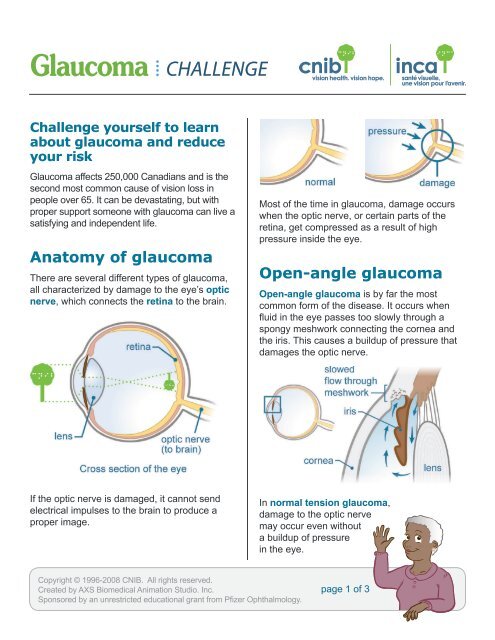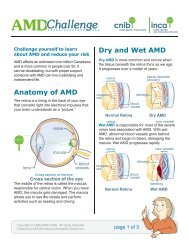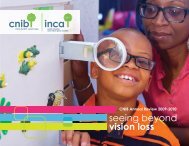Anatomy of glaucoma Open-angle glaucoma - CNIB
Anatomy of glaucoma Open-angle glaucoma - CNIB
Anatomy of glaucoma Open-angle glaucoma - CNIB
- No tags were found...
You also want an ePaper? Increase the reach of your titles
YUMPU automatically turns print PDFs into web optimized ePapers that Google loves.
Closed-<strong>angle</strong> <strong>glaucoma</strong>In closed-<strong>angle</strong> <strong>glaucoma</strong>, the distancebetween the cornea and the iris closescompletely, stopping fluid from draining from theeye.Over time this can expand to “tunnel” vision oreven complete vision loss.Acute closed-<strong>angle</strong> <strong>glaucoma</strong> is a medicalemergency and has a sudden onset <strong>of</strong>symptoms:• Severe eye pain• Headaches (especially in dim light)• Blurred vision• Nausea• Redness in the eye• Haloes around lightsIf you have these symptoms, see youreye doctor or go to an emergency roomimmediately – it could save your sight.In the acute form <strong>of</strong> closed-<strong>angle</strong> <strong>glaucoma</strong>,this happens suddenly, <strong>of</strong>ten in a matter <strong>of</strong>hours. In chronic closed-<strong>angle</strong> <strong>glaucoma</strong>,this can take weeks or even years.Detecting GlaucomaGlaucoma symptoms<strong>Open</strong>-<strong>angle</strong> <strong>glaucoma</strong> and chronic closed<strong>angle</strong><strong>glaucoma</strong> begin without any symptoms.There is no pain, and vision loss isn’t noticeableat first. If left untreated, <strong>glaucoma</strong> causes agrowing area <strong>of</strong> vision loss on the periphery <strong>of</strong>vision.Most eye doctors use a variety <strong>of</strong> tests to checkfor <strong>glaucoma</strong>. These include a tonometry test,which measures pressure inside the eye (called“intraocular pressure,” or IOP).Since <strong>glaucoma</strong> <strong>of</strong>ten has nosymptoms, having regulareye exams is the singlemost important thing youcan do to prevent it.Copyright © 1996-2008 <strong>CNIB</strong>. All rights reserved.Created by AXS Biomedical Animation Studio. Inc.Sponsored by an unrestricted educational grant from Pfizer Ophthalmology.page 2 <strong>of</strong> 3
Risk factorsNon-modifiable risk factors are things youcan’t change:• Increased age• Female gender• Naturally high levels <strong>of</strong> pressure in theeye• Family history <strong>of</strong> <strong>glaucoma</strong>• Nearsightedness• Ethnicity: People <strong>of</strong> African or Hispanicdescent have a greater risk <strong>of</strong> open<strong>angle</strong><strong>glaucoma</strong>. Those <strong>of</strong> Asian or Inuitdescent have an increased risk forother types <strong>of</strong> <strong>glaucoma</strong>.You can change modifiable risk factors:• Manage diabetes and high bloodpressure.• Protect your eyes from injuries andinfections.• If you have other risk factors, talk toyour eye doctor before usingantihistamines, antidepressants,dilating eye drops or steroids, orbeginning a weight training programAnd don’t forget your regular eye exams!Cure and treatmentThere is no cure for <strong>glaucoma</strong>. It can be treatedif detected early, preventing further damage.Treatment usually involves eye drops to lowerthe pressure in your eye. In some cases, yourdoctor may recommend laser or conventionalsurgery if eye drops are not effective.To prevent vision loss, it is important to takeyour eye drops exactly as prescribed even ifyou have no symptoms.More information• <strong>CNIB</strong>http://www.cnib.ca/<strong>glaucoma</strong>• Glaucoma Canadawww.<strong>glaucoma</strong>canada.com• Canadian Ophthalmological Society/ TheCanadian Glaucoma Societyhttp://www.eyesite.ca/cgs/info• The Canadian Association <strong>of</strong>Optometristswww.opto.ca/en/public/04_eye_info/04_02_01_eye_diseases.asp#15• National Eye Institute, U.S. NationalInstitutes <strong>of</strong> Healthwww.nei.nih.gov/nehep/<strong>glaucoma</strong>.aspCopyright © 1996-2008 <strong>CNIB</strong>. All rights reserved.Created by AXS Biomedical Animation Studio. Inc.Sponsored by an unrestricted educational grant from Pfizer Ophthalmology.page 3 <strong>of</strong> 3











